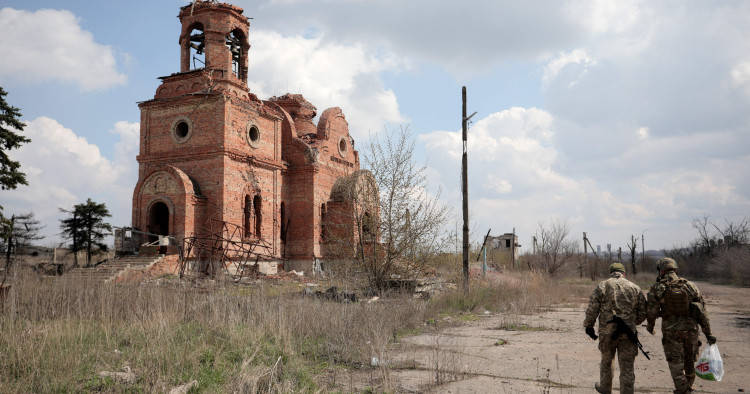Contents:
- 1,000 days of war in Ukraine
- Cease-fire deal on Lebanon taking shape, but formidable obstacles remain
- Gaza nears collapse and West Bank annexation fears intensify as war crimes accusations spark global outrage
- Will the US abandon Sudan under Trump?
1,000 days of war in Ukraine
Iulia-Sabina Joja
Director, Black Sea Program

-
Ukrainians’ determination to fight for their country and their freedom for close to three years has been more than remarkable given the overmatched and largely unrestrained enemy they have stood against.
-
Donald Trump’s reelection in the US portends significant pressure on Kyiv next year to agree to negotiations with Moscow, which may result in an almost certainly temporary cease-fire and freezing of the conflict; but the key issue to consider will be Russia’s capacity to rearm and regroup for a future war.
On Nov. 20, Ukraine marks 1,000 days of Russia’s full-scale invasion and soon three years of war. But despite having suffered countless casualties, millions of refugees, and hundreds of shattered communities, it continues to maintain stiff resistance. In retrospect, calling Ukrainians’ determination to fight for their country and their freedom “remarkable” would be an understatement given the overmatched and largely unrestrained enemy they have stood against. And looking back, it has also become clear that Russia’s aggression was motivated first and foremost by Kyiv’s pro-Western orientation: Ukraine could never have posed a physical threat to the much larger and nuclear-armed Russian Federation, and Ukraine’s capacity to continue to defend itself has materially depended entirely on support from the West.
As former Supreme Allied Commander Europe Gen. (ret.) Philip Breedlove and this author argued in a recent episode of the Middle East Focus podcast, however, that Western support has been sufficient to keep Ukraine from losing but not enough to ensure it could win. Led by the United States, the West’s strategic response to this war has been driven by a self-deterrent fear of escalation with Russia, leading to heavy restrictions in both the quantity and quality of arms sent to Ukraine to defend itself. An illustrative example has been the US provision of stand-off missile artillery systems with caveats. For many months, Ukraine’s leadership publicly called on the American side to allow Ukrainian forces to use the long-range weapons they received from the US, including the MGM-140 Army Tactical Missile System (ATACMS), to attack Russian military positions inside Russia proper. The Biden administration finally relented over the weekend and agreed that Ukraine could use these missiles to carry out “limited” strikes against targets across the border. Yet the long delay enabled the Russian side to prepare by withdrawing many of its potentially vulnerable units and adapt its tactics. At the same time, Ukraine’s inability to freely attack the sources from which Russia launches missiles against the entire territory of Ukraine had forced Kyiv to expend costly air-defense ammunition to partially shield civilian centers.
Despite operating under such heavy restrictions from its Western allies for nearly three years, Ukraine managed to critically erode Russia’s military arsenal and to score some strategic wins of its own, including the liberation of Kharkiv and Kherson, the significant reduction of Russia’s navy, and the Kursk incursion. Donald Trump’s reelection in the US portends significant pressure on Kyiv next year to agree to negotiations with Moscow, which may result in an almost certainly temporary cease-fire and freezing of the conflict. Meanwhile, the political will necessary to push through another significant supplemental US aid package for Ukraine seems to have fizzled. Europeans could take over leadership on continuing the West’s support for Ukraine, but their governments are also unlikely to muster the political will or sufficiently speed up the expansion of their military-industrial production bases.
The key issue for any future negotiations will be Russia’s capacity to rearm and regroup for a future conflict. In other words, what sorts of sanctions reductions and how much of captured Ukrainian territory — along with the resources, populations, and military-industrial assets found there — will the West be willing to offer Moscow in return for a promised end to hostilities? If, after the guns are silenced, the Kremlin is left with the ability to quickly rebuild its military and sees no major future obstacles to its unchecked revanchism, a lasting and sustainable peace in the shared interest of Ukraine and the West is unlikely to be reached.
Follow: @IuliJo
Cease-fire deal on Lebanon taking shape, but formidable obstacles remain
Patricia Karam
Non-Resident Scholar

-
The latest flurry of negotiations suggests that an agreement on a cease-fire in Lebanon may come soon and that Hezbollah may in fact have responded positively to an initial Israeli offer.
-
But ultimately, the successful negotiation of an end to the hostilities will not only be a function of cease-fire monitoring plans and mechanisms but also of Israel’s openness to reaching a deal that does not require the complete surrender of Hezbollah.
Over the past week, media outlets have been citing sources alleging that Israel is pushing a cease-fire to end the conflict between Hezbollah and Israel as an early “gift” to President Donald Trump in January. However, the latest flurry of negotiations — and US special envoy Amos Hochstein’s current visit to Beirut, in which he reported a “real opportunity” and “significant progress” toward ending the conflict — suggests that an agreement may come earlier and that Hezbollah may in fact have responded positively to an initial Israeli offer. Israel’s offensive against the group, which escalated in September, dealt a fateful blow to the latter’s command-and-control structure and arms arsenal, in addition to exacting a heavy civilian death toll and causing the displacement of over a million Lebanese. In recent days, Israel further stepped up its air and ground offensive against Shi’a areas and targets, including the southern suburbs of Beirut, killing Hezbollah’s spokesperson and forcing the Lebanese group to come to the table and discuss a cease-fire proposal.
Any sustainable truce will require the implementation of United Nations Security Council Resolution 1701, which ended the 2006 war between Israel and Hezbollah and demands that no armed groups other than the Lebanese army and UN forces be deployed south of the Litani River, some 30 kilometers north of the Israeli border. Indeed, to be acceptable to Israel, a deal would have to compel Hezbollah’s retreat behind the Litani, from where Hezbollah militants have been staging attacks against Israel, in return for Israeli forces’ withdrawal from Lebanon. This all hinges on Hezbollah’s readiness to pull back behind the military line and the Lebanese government’s ability and willingness to secure the territory. Recent proposals under discussion allow Israel to overreach in case of violations by Hezbollah, which is a red line for Lebanon’s government. Therefore, the Lebanese Armed Forces will need bolstering so they can deploy south and oversee any future buffer zone. Ultimately, the successful negotiation of an end to the hostilities will not only be a function of cease-fire monitoring plans and mechanisms but also of Israel’s openness to reaching a deal without the complete surrender of Hezbollah.
Gaza nears collapse and West Bank annexation fears intensify as war crimes accusations spark global outrage
Carol Daniel Kasbari
Non-Resident Scholar

-
Acute food, water, and medicine shortages in Gaza worsen as Israeli restrictions block aid, with UNRWA and the United Nations warning of a man-made disaster; meanwhile, Human Rights Watch and the UN report mass displacement, attacks on civilians, and use of white phosphorus, calling for independent investigations into potential war crimes.
-
Expecting a more consenting Trump administration next year, Israeli far-right leaders are pushing for further settlement expansions and annexation measures in the West Bank.
The situation in Palestine has reached a critical juncture, with the humanitarian crisis in the Gaza Strip deepening, allegations of war crimes intensifying, and a renewed push toward annexation of the West Bank threatening regional stability. These interconnected issues demand a coordinated international response that not only addresses the immediate humanitarian needs but also lays the groundwork for long-term political solutions.
Gaza’s humanitarian catastrophe has reached unprecedented levels. Over 2 million residents face acute shortages of food, water, and medical supplies, with nearly 80% relying on humanitarian assistance. The Integrated Food Security Phase Classification (IPC) warns of famine risk in the territory, exacerbated by blockades and the destruction of infrastructure during the ongoing conflict. Gazan hospitals are overwhelmed, with the World Health Organization (WHO) reporting critical shortages of essential supplies. Aid efforts are hampered by Israel’s restrictions, which Philippe Lazzarini, the commissioner general of the United Nations Relief and Works Agency for Palestine Refugees in the Near East (UNRWA), described back in February as creating a “man-made disaster,” preventing life-saving assistance from reaching those in desperate need. Two months later, he referred to the situation as a “man-made famine.” The suspension of critical UNRWA operations has left millions vulnerable, highlighting the urgent need for a UN-supervised humanitarian corridor to ensure continuous aid delivery.
Amid this humanitarian catastrophe, allegations of war crimes in Gaza have drawn global condemnation. Reports from Human Rights Watch (HRW) and the United Nations document mass displacement, attacks on civilian infrastructure, and the use of white phosphorus in populated areas. HRW has accused Israeli authorities of crimes against humanity, citing the forced displacement of 1.9 million Palestinians as deliberate and systematic, potentially amounting to ethnic cleansing. The UN has echoed these concerns, emphasizing the need for independent investigations to ensure justice. The systematic nature of these actions, which have caused widespread civilian suffering, has intensified global calls for accountability and adherence to international law.
Meanwhile, the threat of annexation in the West Bank has gained momentum, driven by the empowerment of far-right Israeli leaders and the expected shifts in US policy under Donald Trump’s incoming administration. Figures like Israel’s Finance Minister Bezalel Smotrich openly advocate for extending Israeli sovereignty across the West Bank, intensifying settlement activities, and diminishing Palestinian territorial integrity. President-elect Trump’s planned appointments of figures such as Mike Huckabee, a vocal supporter of Israeli settlements who is supposed to serve as US ambassador to Jerusalem, underscore the likelihood of accelerated annexation efforts with at least tacit American acceptance. Such moves directly threaten the viability of a two-state solution while exacerbating tensions on the ground, further displacing Palestinians, and deepening resentment.
The worsening conditions in Gaza and the annexation threat have sparked a strong response from the global community. International and non-governmental organizations as well as foreign governments have called for Israel to allow unhindered humanitarian access and to respect human rights norms. Moreover, nearly 90 US Congressional Democrats recently urged the Biden administration to sanction key Israeli figures, including Smotrich and Minister of National Security Itamar Ben-Gvir, citing their roles in advancing annexation and human rights violations. But with Prime Minister Benjamin Netanyahu expecting almost all remaining US pressure on him to dissipate after Trump’s return to the White House, it is unclear that this international or Congressional resolve will have much of an impact, especially in the short term.
Follow: @CarolDkas
Will the US abandon Sudan under Trump?
Jehanne Henry
Non-Resident Scholar

-
As Donald Trump prepares to take office in January, his past actions on Sudan offer little consolation to those who desperately want to see an end to this devastating, now 19-month-long civil war.
-
Neither the Sudanese Armed Forces nor the paramilitary Rapid Support Forces have shown a willingness to end the fighting, likely due to their support from external actors, which are expected to play a key role in determining the conflict’s trajectory.
As President Joe Biden wraps up his time in office, so too will his special envoy for Sudan, Tom Perriello. But as the envoy races to achieve whatever he can in the weeks remaining, the future of US policy on Sudan is anyone’s guess. President-elect Donald Trump focuses on deals, not norms, and is known for unpredictability, hostility to democratic ideals, and MAGA-inspired isolationism. His past actions on Sudan, which some perceived as positive at the time, offer little consolation to those who desperately want to see an end to the war.
Sudan is now 19 months into a devasting war between the Sudanese Armed Forces (SAF) and the paramilitary Rapid Support Forces (RSF), which were allied during the transitional period but fell out in mid-2022 over the prospect of merging into one force. Their fighting has all but destroyed the capital Khartoum and other major towns, and it has engulfed most of the country, with the army now controlling the north and east and the RSF controlling the capital and areas to the south and west, including most of Darfur.
The impact on civilians has been horrific. A new mortality study found that more than 60,000 people died in Khartoum state alone, suggesting that the overall death toll could be in the hundreds of thousands. The violence and deprivation have forced more than 10 million to flee their homes, including 3 million to neighboring countries. Half the population faces acute hunger and famine has set in at a large displacement camp in North Darfur.
Both sides are attacking civilians with impunity, driving new wedges between communities and provoking some to take up arms. The RSF is responsible for most of the documented crimes to date. In recent weeks alone, fighters have gone on a rampage in Gezira state, attacking dozens of villages, killing well over a hundred, and raping and detaining scores in apparent retaliation for the defection of one of their commanders. These crimes, like those committed by the RSF against ethnic Masalit communities in West Darfur in 2023, could amount to crimes against humanity.
Neither Abdel Fattah al-Burhan of the SAF nor Mohamed Hamdan Dagalo (“Hemedti”) of the RSF has shown a willingness to stop, likely because they have support from external actors, even though a military victory by either seems out of reach. The United Nations and the media have documented how the United Arab Emirates supports the RSF, while the SAF has received weapons and support from Egypt, Iran, and Turkey, undermining efforts to bring the war to an end. Until recently, the various mediation efforts were disjointed, with the United States and Saudi Arabia trying unsuccessfully to secure a humanitarian cease-fire, while other efforts in Cairo, Manama, Addis Ababa, and Juba seemed to go nowhere.
A new coalition, the Aligned for Advancing Lifesaving and Peace in Sudan (ALPS) Group, could help align efforts, but Perriello will not likely see peace talks before his time is up. To his credit, he has consulted widely with a range of civilian groups that should have a say in the fate of the country once the warring sides stop fighting. Such work is vital but doesn’t yield short-term wins.
Will the Trump administration be different?
Both generals welcomed the election results in the US. They might hold the view — not uncommon among African leaders — that Republican administrations are more effective. It was George W. Bush who delivered the 2005 Comprehensive Peace Agreement ending Sudan’s long civil war in the South, and it was Trump, in his first term, who removed Sudan from the state sponsor of terrorism (SST) list in December 2020, opening the door to international assistance and financing.
But Trump’s action was hardly benevolent — it was a quid pro quo for Sudan agreeing to sign the Abraham Accords with Israel, joining the UAE, Bahrain, and Morocco in a US-backed initiative to change the region. Sudan also had to pay $335 million to settle claims by victims of the 1993 terrorist attacks on US embassies in East Africa.
This legacy does not seem relevant in today’s Middle East, gripped by dangerous new wars. Trump looks set to cater to Israeli interests. While this doesn’t exclude a regional deal with Arab states or Iran, it could imply turning a blind eye to the war ripping apart Sudan.
Analysts predict that regional powers like Egypt, the UAE, and Saudi Arabia will decide the country’s fate. In other words, regional realpolitik rather than normative interventions of the past will likely rule the day. What this means is anyone’s guess, but it looks bleak considering how little interest regional powers have shown in ending Sudan’s war.
Follow: @jehannehenry
Photo by Photo by Aleksey Filippov / AFP via Getty Images
The Middle East Institute (MEI) is an independent, non-partisan, non-for-profit, educational organization. It does not engage in advocacy and its scholars’ opinions are their own. MEI welcomes financial donations, but retains sole editorial control over its work and its publications reflect only the authors’ views. For a listing of MEI donors, please click here.













